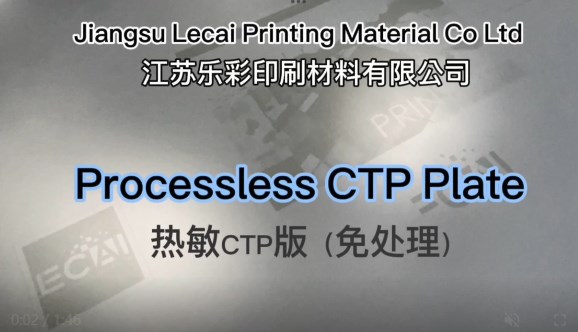2025-10-22
In the modern printing industry, platemaking technology has always been a core component of production efficiency and print quality. With the advancement of digitalization and environmental awareness, traditional platemaking methods are increasingly facing challenges such as high costs, complex processes, and environmental pressures. Against this backdrop, processless plates have emerged as a focal point of technological innovation in the printing industry.
Technical Principles of Processless Plates
Processless plates are printing platemaking materials that can be used directly for printing without traditional washing or developing processes. Their core principle is to transform graphic information directly into printable patterns through advanced photosensitive coating technology. These plates typically consist of a photosensitive coating and a substrate. The printed image is created directly on the plate using digital printing equipment or laser platemaking equipment. Their most significant feature is that they eliminate the multiple washing, developing, and chemical treatment steps required in traditional platemaking, achieving a seamless transition from design to printing.
Chemically, the photosensitive coating of processless plates undergoes a photosensitivity reaction upon exposure, allowing printing ink to selectively adhere to the imaged area while maintaining oleophobic properties in non-imaged areas. This chemical selectivity not only ensures high precision and resolution of printed images, but also significantly reduces chemical waste discharge, which is of great significance for environmental protection and operational safety.
Advantages of Processless Plates
Compared to traditional platemaking, processless plates offer several unique advantages. Firstly, efficient production. Traditional platemaking often requires multiple steps, including developing, rinsing, and drying. Processless plates can complete the platemaking process in minutes, significantly reducing pre-printing time and improving production efficiency.
Environmental protection and cost savings are also significant features. The lack of chemical processing means that printing companies no longer need to deal with large amounts of wastewater, reducing the risk of environmental pollution. Furthermore, by saving on rinsing fluids, developers, and water, companies can significantly reduce material and energy consumption. This is of great value in today's printing industry, where sustainability is increasingly important.
Processless plates offer excellent image accuracy and printing stability. The photosensitive coating technology precisely controls ink adhesion, ensuring the clarity and color reproduction of printed images. Processless plates provide reliable quality assurance for demanding packaging, commercial, and high-end label printing.

Application Scenarios for Processless Plates
As technology matures, their use in printing production is becoming increasingly widespread. Their efficiency and environmental friendliness significantly enhance production flexibility, particularly in quick-run, short-run, and personalized printing. Companies can quickly adjust print content based on market demand, eliminating the long lead times associated with traditional platemaking, enabling them to better respond to customer needs.
In packaging printing, processless plates maintain high-precision image output, achieving high-fidelity reproduction of even complex color gradients and fine text. This allows brands to achieve greater creative expression in product packaging design while ensuring consistent and stable printing quality.
Processless plates hold great potential for integration into digital printing and automated production lines. Combined with digital printing systems, processless plates enable fully automated operations, further reducing labor costs while improving production reliability and product consistency.
As an innovative technology in the printing platemaking field, processless plates are reshaping the landscape of modern printing production with their efficiency, environmental friendliness, and high precision. They not only simplify traditional platemaking processes and improve production efficiency, but also provide printing companies with a greener, more cost-effective production method. As the technology continues to mature and its application scenarios continue to expand, Processless Plate is expected to become an important support for the standardization and digital development of the printing industry, providing printing companies with continuous technological advantages in the fierce market competition.